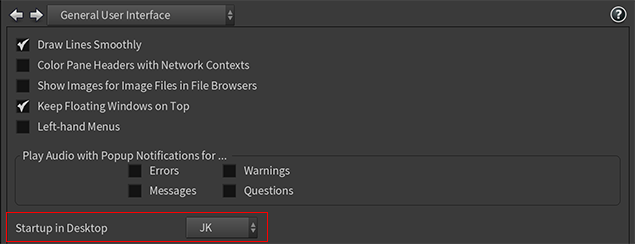Difference between revisions of "Customizing the Houdini Interface"
Views
Actions
Namespaces
Variants
Tools
| Line 13: | Line 13: | ||
You can switch between desktops using the [https://www.sidefx.com/docs/houdini/basics/panes.html#layouts menu at the top of the main window] [[File:desktop_radial_menus.png]] | You can switch between desktops using the [https://www.sidefx.com/docs/houdini/basics/panes.html#layouts menu at the top of the main window] [[File:desktop_radial_menus.png]] | ||
By default Houdini starts up in the Build desktop, but you can change that [https://www.sidefx.com/docs/houdini/ref/windows/mainprefs.html#ui | By default Houdini starts up in the Build desktop, but you can change that in the [https://www.sidefx.com/docs/houdini/ref/windows/mainprefs.html#ui Edit Preferences General User Interface] [[File:startup_desktop.png]] | ||
== Simplifying Node Shapes == | == Simplifying Node Shapes == | ||
Revision as of 01:19, 15 October 2021
Houdini provides almost limitless customization, it's easy to be overwhelmed at first as there's lots of different places where you change settings.
Outlined below are the steps I take to customize Houdini to my liking.
Get the Slate Theme
To get a flat user interface, I'm using this Slate Theme from Odforce I found a while ago. It eliminates a lot of the shading on UI elements like buttons and tabs. I find it easier on the eyes as well as more simplified modern look.
The theme can be downloaded here Slate_Theme_Houdini.zip, unzip the files and put them in your $HOME/houdiniX.x/config/ directory. The next time you launch Houdini, you should see the Slate theme as an option in your Edit ► Color Settings Window
Changing the Desktop Layout
Download the .desk file and place it in your local preferences desktop directory $HOME/houdiniX.x/desktop/
You can switch between desktops using the menu at the top of the main window 
By default Houdini starts up in the Build desktop, but you can change that in the Edit Preferences General User Interface 
Simplifying Node Shapes
https://www.sidefx.com/docs/houdini/network/menus.html#view_menu
Show Custom Node Shapes ► Disable, so all nodes are rectangular
https://www.sidefx.com/docs/houdini/network/menus.html#tools_menu
Make Room for New Nodes ► Disable
https://www.sidefx.com/docs/houdini/ref/windows/mainprefs.html#net
Use simplified shape when node shapes ► Enable, uses an even simpler default node shape (a simple rectangle instead of a rounded rectangle)
Animate network changes ► Disable
https://www.sidefx.com/docs/houdini/network/options.html#display
Default node colors ► Disable
Node size to show ring ► never show the ring
Changing the Splash Screen
Some aspects of Houdini can only be customized through Setting Houdini Environment Variables.
You can customize the following Houdini Environment Variables by editing $HOME/houdiniX.x/houdini.env
HOUDINI_SPLASH_FILE = ~/hsplash/hsplash_014.png
HOUDINI_SPLASH_MESSAGE = "Welcome//n${USER} @ ${HOSTNAME}//n${HOUDINI_VERSION}//nGood Luck!"
HOUDINI_NO_START_PAGE_SPLASH = 1
HOUDINI_ANONYMOUS_STATISTICS = 0
HOUDINI_LMINFO_VERBOSE = 0
HOUDINI_ENABLE_OLD_PRESETS = 1
HOUDINI_USE_OTL_AS_DEFAULT_HDA_EXT = 1
HOUDINI_MAX_FILE_HISTORY = 32
HOUDINI_UI_QUEUE_SIZE = 2500000
# When enabled, Houdini will output OpenCL memory usage statistics after every set of OpenCL kernel calls.
# HOUDINI_OCL_REPORT_MEMORY_USE = 1
# GPUS FOR REDSHIFT
#REDSHIFT_GPUDEVICES=0,1
#REDSHIFT_GPUDEVICES=0